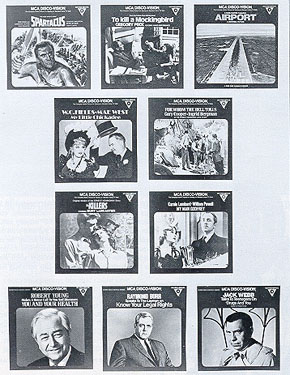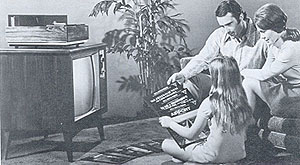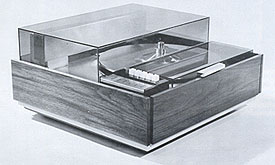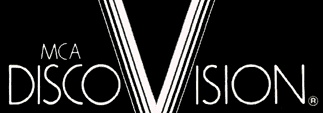|
At Universal City, California, on December 12, 1972, MCA Inc. presented a star-filled video disc
entertainment at the first public showing of its new DISCO-VISION system.
More than 300 press and industry executives viewed color and black-and-white excerpts from
Universal's vast film library shown via DISCO-VISION on the screens of a variety of home television sets.
The presentations were made to approximately 150 members of the press at 11:30am and a similar
 number of entertainment, retailing and electronic manufacturing executives at 4pm at Universal's Stage 24.
number of entertainment, retailing and electronic manufacturing executives at 4pm at Universal's Stage 24.
In addition to ending years of industry speculation on when and how the showing of films on home
television sets could be achieved at popular prices, the demonstrations that day took on additional stature with the
attendance of the MCA Inc. Board of Directors in advance of a regular board meeting.
Lew R. Wasserman, President and Chief Executive Officer of MCA Inc., welcomed the guests at both
viewings "to share in MCA's progress report on the research and development of our company's new technology." The
demonstration, he pointed out, was not a consumer introduction.
The DISCO-VISION presentation included seven minutes of scenes from 22 musicals, comedies and
dramatic motion pictures from Universal's immense film library of more than 11,000 titles, encompassing the years 1930 to
1972, and featuring many of the top stars of those years.
The audiences saw the DISCO-VISION program on brand-name standard home TV receivers.
Preceding each of the demonstrations, John W. Findlater, MCA Vice President and President of MCA
Disco-Vision, Inc., described the new home entertainment and information storage and retrieval process, its research,
development and history to date. His remarks were as follows:
We believe we've achieved the ultimate concept in home entertainment and information storage and
retrieval systems, and that both the hardware and the software will be sold to the consumer at popular prices.
These replicated discs are capable of storing 40 billion bits of information permitting up
to 40 minutes of playing time per side. In fact, it's possible to store the Social Security number of every person
in the United States on just one side of one disc!
You'll view the disc - one of which I'm holding and the other of which you see on the player
there - today on standard-brand TV sets which we purchased from local retailers.
MCA DISCO-VISION is the first optically-read system to be demonstrated from a replicated
disc. We are not working from a master. What you'll see is an end-product demonstration of the disc itself.
MCA DISCO-VISION is the first disc system to demonstrate more than five minutes of
programming.
Today, we're highlighting the entertainment aspects of DISCO-VISION, although there are
numerous additional applications for this technology, giving DISCO-VISION an enormous range of business, educational and
other uses.
The replicated demonstration disc you'll see is a composite of scenes from 22 Universal films -
both color and black-and-white, ranging from 1930 to 1972 productions. These subjects span the entire historical spectrum
of changing film technology, from the old black-and white nitrate negatives of the 30's to Technicolor's three-stripe
nitrate negatives, culminating in Kodak's color negative of the 70's. The ability to produce a balanced uniform print
from this heterogeneous mixture of widely divergent film sources, each with its own different color balance and contrasts,
and to transfer each to our replicated disc, confirms the discs versatility.
Both the seven-minute running time and the selection of the 22 titles were arbitrary decisions.
We could just as well have chosen 8, 10, 15 or 20 minutes of programming. But it seemed to us that seven minutes
constituted a truly representative sample.
However, those of you who would like to view a disc with 20 minutes or more of recorded information
may contact us after the demonstration and we'll be happy to arrange in-lab group viewings.
SRI - Stanford Research Institute - is making a comprehensive, in-depth study of the manufacturing,
marketing and distribution fundamentals for us. We prefer to await their recommendations before making any definitive
decisions in those areas.
However, since we do want to share our knowledge, ideas and all available information with you to
the utmost of our ability - Kent Broadbent, Vice President of MCA DISCO-VISION, Inc., and director of R & D on this
project, and I - both of us - will be available after the demonstration should you have further inquiries.
And now, I'm very proud to present...MCA's DISCO-VISION!
There then followed the actual demonstration, in which a standard "for sale" replicated
DISCO-VISION mylar disc (not a master) was used to project clips from 22 films (old and new, black and white and
color) onto the tubes of six off-the-shelf standard TV receivers, each of which bore the brand name of a different
manufacturer.
Members of the select press and VIP audience present were obviously much impressed and unanimous
in their praise of the system's clarity, sharpness and fidelity of color rendition.
At the close of the formal presentation, guests visited a decorated room setting showing the
DISCO-VISION system as part of the home entertainment center. Also on view were sample DISCO-VISION albums, representing a
 variety of Universal products (full-length features, documentaries, cartoons, short subjects, educational and cultural
films, etc.) which the company anticipates it will market on the video disc, as well as several illustrative samples of
subjects which will be produced especially for DISCO-VISION.
variety of Universal products (full-length features, documentaries, cartoons, short subjects, educational and cultural
films, etc.) which the company anticipates it will market on the video disc, as well as several illustrative samples of
subjects which will be produced especially for DISCO-VISION.
Room setting illustrates the way the MCA DISCO-VISION player unit will look atop a
home television set. Model family is choosing a video disc album from an illustrative sampling of program material from
Universal's film library.
MCA® DISCO-VISION
General Facts and Specifications
What it is:
MCA DISCO-VISION is a new technology whereby a variety of information sources recorded on a thin,
flexible video disc can be shown on standard home television screens by means of a disc changer/player attachment. The
changer/player unit will provided a minimum of three hours or less and a maximum of 6-2/3 hours of unattended playing time.
A single-disc player is also available. DISCO-VISION is a product of MCA Inc.'s research and development in the field of
low-cost, high density audio-video information recording and storage.
General Information:
The DISCO-VISION playback unit is attached to the VHF antenna input terminals of any standard home
television receiver and may be tuned to a channel which is not used for regular television programming. There is no
pick-up stylus. The playback unit employs an optical system with a non physical contact, low-powered helium-neon laser
read-out which picks up the images and relays them electronically to the TV screen.
The Disc:
The 12-inch diameter DISCO-VISION disc is made of plastic sheet, typically mylar, is .010-inch
thick, and provides full color / black-and-white, high-resolution pictures for a minimum of 20 minutes and a maximum of
40 minutes playing time per side.
The disc, which closely resembles an ordinary long-playing phonograph record, is pressed in
essentially the same way and is virtually indestructible, thus providing easy distribution by mail. It is metallized to
permit handling with no more care than that required of regular phonograph records. It has its own plastic tray container
so that the disc can be inserted into the changer without physical contact. This tray is 12½ inches x 12½
inches x ¼ inch. The disc is recorded on one side only.
The program material appears on the disc in the form of a spiral running from the outer diameter
of the disc inward with a pitch of 80 micro-inches per revolution. Density is 12,500 tracks per radial inch. The disc
revolves at a rate of 30 revolutions per second and is played back by a laser beam. This beam is electronically steered
to follow the recorded information spiral without making contact with the information track itself. The non-physical
contact playback system eliminates record ware and provides an unlimited disc-playing life with proper user handling.
The Disc Album:
DISCO-VISION discs will be housed in a plastic changer-compatible tray enclosed in a cardboard
sleeve container. These albums will be available in several versions, typical of which are 12½ inches square and
3/8 inch thick for single discs, and 12½ inches square and ¾ inch thick, holding five discs capable of 200
minutes of playing time. Recording on only one side of the disc allows play of the complete album without an interruption
to turn over the stack.
The single and multiple disc albums are designed to sell for suggested list prices of $1.99 to
$9.95 each depending on content, length and subject.
Player Units:
The DISCO-VISION multiple-disc player/changer is a covered unit of metal construction with walnut
grain finish and smoked plastic cover. It permits the user to stack up to 10 discs for a playing time of up to 6-2/3 hours
and can play pre-recorded information source material in either color or black-and-white in an unlimited number of standard
television receivers or monitors simultaneously when fed by an appropriate distribution amplifier. There are six
 push-button controls [Power, Play, Stop, In, Out, Reject] on the front of the machine which are accessible with the lid
closed. The dimensions are 22¾ inches wide x 18 inches deep x 11 inches high and the weight of the unit is less
than 50 lbs. It is expected to retail for under $500.
push-button controls [Power, Play, Stop, In, Out, Reject] on the front of the machine which are accessible with the lid
closed. The dimensions are 22¾ inches wide x 18 inches deep x 11 inches high and the weight of the unit is less
than 50 lbs. It is expected to retail for under $500.
The unit's capability is such that at the touch of a control the action can be "frozen" and held
or repeated over again or short sequences can easily be selected and played at will. There is also a single-disc player
[image on the right] with dimensions of 16¾ inches x 18 inches x 8½ inches, weighing less than 40 lbs. Its
design is similar to that of the multiple-player unit, and it is expected to retail for under $400.
Playing the Album:
The DISCO-VISION multiple-disc album will be placed on the player/changer and discs automatically
loaded onto the player turntable, played in sequence and returned to the album. It is slot-loaded with a flexible disc
on its tray inserted, played automatically and ejected in its tray. The change time from record to record is approximately
four seconds.
Smaller albums and/or single discs may be loaded and played in any combination or order and may be
added to the unplayed stack and withdrawn from the played stack at any time.
Technical Data:
The DISCO-VISION format is standard NTSC 525 lines, 60 fields. The disc drive speed is 1,800RPM,
and there are more than 300 lines of horizontal color resolution. Audio and video signal-to-noise ratios are each greater
than 40 dB. Two channels of audio are available for stereo and special applications.
Laser Beam:
The DISCO-VISION playback laser is an inexpensive, low-power one milli-watt unit and has an expected
useful life of approximately 9,000 hours, or approximately five hours of playing time per day over a five-year period,
which is far in excess of the useful life of pressure systems employing magnetic heads or diamond stylus pickups. After
9,000 hours, it can be replaced simply and quickly.
Since the laser playback system is electronically steered to follow the information track, it may
be programmed to read the same track innumerable times, providing stop action or freeze frame, with no wear imposed on the
re-read information track, and with precise selection of the information to be re-traced. The laser light reflected from
the information track of the disc provides the information for the audio and video program as well as for maintaining the
laser beam on the track.
Film Transfer:
Motion picture film may be fed directly into the DISCO-VISION mastering machine from a film chain
or may be transferred to a professional magnetic video tape which is then played into the disc mastering unit. Mastering
from tape, film or live sources is accomplished in a real time process using laser and electro-optical modulation
techniques for full bandwidth and fidelity. The disc is subsequently processed to produce a nickel-plated stamper from
rich replica discs are produced.
Disc Replication:
The recorded program material is reproduced on DISCO-VISION discs by a variety of processes.
Stamping or embossing sheet mylar is typical, using heat and pressure to deform the surface of thermoplastic sheet
material. The plastic is metallized to allow handling for playing on single-disc player models. Replication cost is
less than 40¢ per disc (not including cost of program material).
Information Storage:
The DISCO-VISION disc has the highest information density ever achieved on any medium. It is
capable of storing approximately 40 billion bits per 12-inch disc. Random (fast) access to stored information is
permitted by radial traversing of disc. The random access capability is accomplished automatically by use of the "in"
and "out" mode control push button of the player unit. The rate of reading recorded information is greater than 30 million
bits per second with the capacity to show in excess of 35,000 slides per disc.
The system permits, in addition to random access, program speed-up, slow-down, stills, reverse, or
picture-by-picture replay.
Proprietary Rights:
MCA DISCO-VISION has what it believes to be truly inventive solutions to the problems of recording
sight and sound information on a disc, replicating the disc and playing back the replicas. The company is confident it has
made several "breakthroughs" in video player and video disc technology which give it substantial competitive advantages.
The master disc and the apparatus that will be used to produce it is one of these breakthroughs. Its techniques for taking
that master and producing "stampers" therefrom and the techniques for maintaining the high information density in pressing
the final record are also significant breakthroughs for which patent protection will be sought.
MCA DISCO-VISION's playback system also includes certain special components. An example is a
playback head system to automatically maintain the head-to-disc spacing and avoid scraping without the need to electrically
servo or adjust this spacing. These component elements are protectible. In addition, the company has its own specially
developed and unique tooling which is involved both in processing the initial laser-produced master through to the final
disc replication stage and the specialized tooling relating to the alignment and optimization of the player equipment.
The company also has some innovative electronic techniques for coping with many problems associated with storing
information on a disc. These techniques and tooling will give DISCO-VISION cost advantages over competitive systems.
MCA DISCO-VISION researchers have developed several options from which to choose a complete system.
The company has inventions related to each of the options. For example, since the company has a choice between a rigid
replica disc and a relatively flexible replica disc, it also has pick-up heads designed to work with each.
Similarly, if the final disc is to be opaque only in the non-information areas, the company has
patents to cover such a disc, and several methods of making it. If, on the other hand, the entire disc surface has the
same degree of transparency or reflectivity, the company expects to be able to protect that disc as well.
To retain these advantages, MCA DISCO-VISION, INC. has established certain information disclosure
parameters in the proprietary areas beyond which the company does not find it prudent to elaborate publicly at this point
in time.
However, it can be disclosed that the company holds six issued patents. Several additional
applications for patent are currently pending. Still other inventions have been disclosed, applications for which are
currently in preparation. Those patents, along with the company's other proprietary rights, establish conclusively that
MCA DISCO-VISION, INC. has created a video disc system from start to finish, from the making of a master to the playback
of a replica disc.
A great deal of sophisticated engineering technology and dedicated work of talented scientists
have produced the MCA DISCO-VISION system. To the extent these breakthroughs can be protected by the United States'
patent system, they have been or will be so protected. To the extent that the company will be able to maintain trade
secrets on the non-patentable items, the company will rely on that protection as well.
Special Features:
Special features and capabilities of the MCA DISCO-VISION system include:
- Low-cost replicated disc - under 40¢ per disc (not including cost of program material).
- Extremely high density information storage - approximately 40 billion bits per 12-inch disc.
- Ability to freeze frame - or repetitively read out a selected information track.
- Random access to stored information - by radial traversing of disc.
- High rate of reading recorded information - greater than 30 million bits per second.
- Search out - fast forward switch.
- Frame crawl feature.
Several applications are suggested by these features and capabilities, described briefly as follows:
Library, Catalog & Archival Storage:
Tens of thousands of single tracks of printed-page facsimilies may be stored on a single 12-inch
disc. Large numbers of books or catalogs could be stored on records where many copies of each are required for wide
distribution. Read-out would be accomplished by a player that continuously scans the selected track or page and displays
it on a cathode-ray tube. Conversion to paper from cathode-ray tube presentation could accomplished via a copy machine.
Teaching Machines:
Audio-visual educational material could be presented on a standard TV receiver using the
DISCO-VISION system. The video disc has the ability to store multiple-answer material which can be selected at will.
When this is used in conjunction with minimal data processing equipment, educational question and answer routines
employing this "branching" and "sub-routine" capability could be continuously feed back a program of appropriate
audio-visual material predicated upon the students' response to initial presentations.
Credit Card Verification:
The inexpensive nature of the replicated disc and the ability to store substantial amounts of
information on a small disc provide an inexpensive mailable storage medium which could be distributed in quantity (on a
weekly basis for example). The disc would contain up-to-date credit information which would be locally accessible in a
matter of seconds using inexpensive office-installed machines. For example, more than 400 million nine-digit numbers
(such as Social Security number) could be stored on a single 12-inch disc, with three-fold redundancy for accuracy.
Replacement of Photographic Prints for Program Material Distribution to TV Stations:
Material for widely-used television programs currently distributed in the form of photographic
film prints or magnetic tapes could be distributed on MCA DISCO-VISION video discs. The ability to lock onto any given
point or frame within the program permits precise and easy cueing and insertion of commercials and other program material.
The non-contact playback system insures long life and consistent high quality.
|


 number of entertainment, retailing and electronic manufacturing executives at 4pm at Universal's Stage 24.
number of entertainment, retailing and electronic manufacturing executives at 4pm at Universal's Stage 24. variety of Universal products (full-length features, documentaries, cartoons, short subjects, educational and cultural
films, etc.) which the company anticipates it will market on the video disc, as well as several illustrative samples of
subjects which will be produced especially for DISCO-VISION.
variety of Universal products (full-length features, documentaries, cartoons, short subjects, educational and cultural
films, etc.) which the company anticipates it will market on the video disc, as well as several illustrative samples of
subjects which will be produced especially for DISCO-VISION. push-button controls [Power, Play, Stop, In, Out, Reject] on the front of the machine which are accessible with the lid
closed. The dimensions are 22¾ inches wide x 18 inches deep x 11 inches high and the weight of the unit is less
than 50 lbs. It is expected to retail for under $500.
push-button controls [Power, Play, Stop, In, Out, Reject] on the front of the machine which are accessible with the lid
closed. The dimensions are 22¾ inches wide x 18 inches deep x 11 inches high and the weight of the unit is less
than 50 lbs. It is expected to retail for under $500.